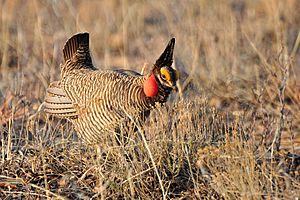Lesser prairie chicken facts for kids
Quick facts for kids Lesser prairie chicken |
|
|---|---|
 |
|
| A lesser prairie chicken in New Mexico | |
| Conservation status | |
| Scientific classification | |
| Genus: |
Tympanuchus
|
| Species: |
pallidicinctus
|
 |
|
| Lesser prairie chicken range. | |
| Synonyms | |
|
Tympanuchus cupido pallidicinctus |
|
The lesser prairie chicken (Tympanuchus pallidicinctus) is a special type of bird that belongs to the grouse family. It looks a lot like its cousin, the greater prairie chicken, but it's usually a bit smaller and has lighter feathers.
These birds mostly live in the central United States. About half of all lesser prairie chickens can be found in western Kansas. You can also spot them in parts of Colorado, Oklahoma, New Mexico, and Texas. They were first officially described in 1873 by a scientist named Robert Ridgway.
Contents
What is a Lesser Prairie Chicken?
The lesser prairie chicken is a medium-sized bird that spends most of its time on the ground. It's known for its unique mating dances, which are quite a sight! These birds are an important part of the prairie ecosystem.
Appearance and Size
Lesser prairie chickens are usually about 15 to 16 inches (38 to 41 centimeters) long. They weigh around 1.5 to 2 pounds (0.7 to 0.9 kilograms). Their feathers are a mix of brown, black, and white, which helps them blend in with the dry grasses of the prairie.
Males and females look similar, but males have some special features. During mating season, male lesser prairie chickens have bright yellow-orange air sacs on the sides of their necks. They also have long feathers called pinnae that stand up on their heads. These features are used to attract females.
Where They Live: Habitat
Lesser prairie chickens live in dry, open grasslands called prairies. They prefer areas with a mix of short and tall grasses, along with some shrubs. These plants provide them with food, shelter from predators, and places to nest.
Their habitat has changed a lot over the years. Many of the prairies where they used to live have been turned into farms or developed for other uses. This loss of habitat is a big problem for these birds.
Life and Behavior
Lesser prairie chickens are mostly active during the day. They spend their time looking for food and avoiding predators.
What They Eat: Diet
These birds are omnivores, meaning they eat both plants and insects. Their diet changes with the seasons. In the spring and summer, they eat a lot of insects like grasshoppers and beetles, which are full of protein. They also munch on seeds, leaves, and berries from various prairie plants. In the fall and winter, they rely more on seeds and plant parts that are still available.
Reproduction and Mating Dances
One of the most amazing things about lesser prairie chickens is their mating ritual. In the spring, male birds gather in special open areas called "leks." A lek is like a dance floor where males perform to attract females.
During these dances, the males puff up their yellow-orange air sacs, fan their tail feathers, and make loud booming sounds. They also stomp their feet and sometimes even jump into the air. Each male tries to show off his strength and health to impress the females. Females visit the lek to choose a mate. After mating, the female builds a nest on the ground, usually hidden in tall grass, and lays her eggs. She raises the chicks by herself.
Conservation Status
The lesser prairie chicken is considered a "Vulnerable" species by the International Union for Conservation of Nature (IUCN). This means their numbers are decreasing, and they could become endangered if we don't protect them.
Threats to Their Survival
The main reasons why lesser prairie chickens are in trouble include:
- Habitat Loss: As mentioned, much of their prairie home has been lost to farming, oil and gas development, and other human activities.
- Habitat Fragmentation: Even if some prairie remains, it might be broken up into small pieces, making it harder for the birds to move around and find mates.
- Climate Change: Changes in weather patterns, like droughts, can affect the plants and insects they rely on for food.
- Predators: With less cover, they are more exposed to predators like coyotes, foxes, and hawks.
Conservation Efforts
Many groups are working hard to protect the lesser prairie chicken. These efforts include:
- Habitat Restoration: Trying to bring back and improve prairie habitats.
- Land Management: Working with landowners to manage their land in ways that help the birds.
- Research: Studying the birds to understand their needs better.
- Public Awareness: Teaching people about the importance of these unique birds and their habitat.
By understanding and protecting the lesser prairie chicken, we can help ensure that these amazing birds continue to thrive in the prairies for future generations.
See also
 In Spanish: Gallo de las praderas chico para niños
In Spanish: Gallo de las praderas chico para niños


